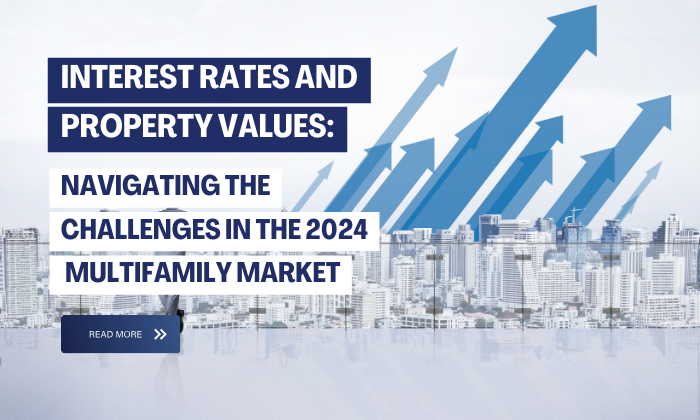The multifamily market is one of the most resilient and attractive sectors in the real estate industry. However, it is not immune to the challenges and uncertainties that the global economy faces in 2024. In this blog post, we will explore how interest rates and property values affect the multifamily market, and how investors and owners can navigate these challenges and find opportunities in the 2024 multifamily market.
Interest Rates and Property Values: The Basics
Interest rates and property values are two of the most important factors that influence the multifamily market. Interest rates affect the cost and availability of financing for multifamily properties, as well as the returns and risks for investors. Property values reflect the supply and demand dynamics of the multifamily market, as well as the quality and performance of the properties.
Generally speaking, there is an inverse relationship between interest rates and property values. When interest rates are low, financing is cheaper and more accessible, which stimulates the demand for multifamily properties and drives up their prices. Conversely, when interest rates are high, financing is more expensive and less available, which dampens the demand for multifamily properties and puts downward pressure on their prices.
However, this relationship is not always straightforward or consistent. Other factors can affect the multifamily market, such as the economic outlook, the housing market trends, the rental market conditions, the supply and demand balance, the demographic and lifestyle changes, and the regulatory and policy environment. These factors can either amplify or mitigate the impact of interest rates on property values, depending on the specific context and situation.
Interest Rates and Property Values: The 2024 Scenario
In 2024, the multifamily market is facing some challenges, as new supply peaks and the economy slows down. According to our market analysis, these are the main trends and drivers of the multifamily market in 2024:
- The economic outlook is uncertain and mixed. The global economy is expected to grow by 3.6% in 2024, according to the International Monetary Fund (IMF). However, this growth is uneven and fragile, as the recovery from the COVID-19 pandemic is still incomplete and uneven across regions and sectors. The IMF warns that the risks to the outlook are tilted to the downside, as the pandemic could worsen, the fiscal and monetary support could fade, the trade and geopolitical tensions could escalate, and the social and environmental challenges could intensify.
- The interest rate forecast is volatile and unpredictable. The Federal Reserve (Fed) has maintained its near-zero interest rate policy since March 2020, in response to the COVID-19 crisis. However, the Fed has also signalled that it will start to taper its asset purchases in late 2023 or early 2024 and that it will raise its benchmark interest rate in 2025, depending on the inflation and employment data. However, the Fed’s policy stance is subject to change, as the economic conditions and expectations evolve. The market participants have different views and expectations on the timing and pace of the Fed’s policy normalization, which creates uncertainty and volatility in the interest rate market.
- The housing market trends are diverging and shifting. The housing market has been booming since the COVID-19 outbreak, as the low-interest rates, the limited supply, the high demand, and the changing preferences have fueled the home-buying frenzy. However, the housing market is showing signs of cooling down in 2024, as affordability issues, inventory shortages, rising mortgage rates, and slowing population growth weigh on the market. The housing market is also undergoing some structural and cyclical changes, such as suburbanization, digitization, environmental sustainability, and the generational transition.
- The rental market conditions are improving and stabilizing. The rental market has been hit hard by the COVID-19 pandemic, as the lockdowns, the income losses, the remote work, and the urban exodus have reduced the demand and increased the vacancy for rental properties. However, the rental market is recovering and stabilizing in 2024, as the vaccinations, the reopenings, the stimulus checks, the job creation, and the return migration boost the demand and occupancy for rental properties. The rental market is also adapting and innovating, as landlords and tenants embrace the flexibility, affordability, convenience, and technology of the rental market.
- The supply and demand balance is peaking and moderating. The multifamily market has been experiencing strong supply growth since 2018, as the developers have responded to the high demand and favourable financing conditions for multifamily properties. However, the supply growth is peaking and moderating in 2024, as the construction costs, labor shortages, zoning restrictions, and market saturation constrain the development activity. The demand growth is also slowing down and levelling off in 2024, as the economic slowdown, the housing competition, the demographic changes, and the lifestyle choices affect the demand for multifamily properties.
Interest Rates and Property Values: The Implications and Strategies
Given the above scenario, what are the implications and strategies for the multifamily market in 2024? Here are some of our insights and recommendations:
- If we achieve an economic soft landing, we believe the multifamily market will continue to see slow growth while it works to absorb the high level of new supply in 2024. As the overall economy slows leading to a softer labor market, multifamily demand is expected to remain positive but weaker compared with pre-pandemic rates. For 2024, our baseline forecast is for rent growth of 2.5% for the year, remaining slightly below the long-term annual average from 2000 to 2022 of 2.9%, according to RealPage. We expect the vacancy rate to remain relatively stable in 2024 despite what we believe will be the peak year for deliveries this cycle. For 2024, we forecast the vacancy rate to be 5.7%, 40 bps higher than the 2000-through-2022 RealPage average of 5.3%.
- If we face an economic hard landing, we believe the multifamily market will face more challenges and pressures in 2024. As the economy contracts leading to a higher unemployment rate, multifamily demand is expected to decline and become more price-sensitive. For 2024, our downside forecast is for rent growth of -1.0% for the year, well below the long-term annual average from 2000 to 2022 of 2.9%, according to RealPage. We expect the vacancy rate to rise significantly in 2024 as the new supply exceeds the weak demand. For 2024, we forecast the vacancy rate to be 7.5%, 220 bps higher than the 2000-through-2022 RealPage average of 5.3%.
- In either case, we believe the interest rates will have a moderate and mixed impact on the property values in 2024. On the one hand, the interest rates are expected to remain low and stable in 2024, which will support the financing and valuation of multifamily properties. On the other hand, the interest rates are expected to rise gradually and eventually in the future, which will increase the financing costs and lower the valuation of multifamily properties. Therefore, the interest rates will have a trade-off effect on the property values in 2024, depending on the timing and magnitude of the interest rate changes, as well as the income and growth prospects of the multifamily properties.
- Therefore, we suggest that investors and owners adopt a prudent and flexible approach to the multifamily market in 2024. We recommend that investors and owners focus on the quality and performance of the multifamily properties, rather than the quantity and price. We advise investors and owners to diversify and optimize their portfolios, by selecting properties that have strong fundamentals, attractive locations, competitive advantages, and value-added potentials. We also encourage the investors and owners to monitor and adapt to the market conditions, by adjusting their strategies, expectations, and actions according to the changes in the economy, the interest rates, the housing market, the rental market, and the supply and demand balance.
Conclusion
The multifamily market is a dynamic and complex sector that is influenced by many factors, such as interest rates and property values. In 2024, the multifamily market is facing some challenges and uncertainties, as the economy slows down, the interest rates fluctuate, the housing market shifts, the rental market stabilizes, and the supply and demand balance moderates. However, the multifamily market is also resilient and attractive, as it offers stable income, diversified risk, and long-term growth. Therefore, we believe the multifamily market is still a viable and profitable sector for investors and owners who can navigate the challenges and find opportunities in the 2024 multifamily market.




